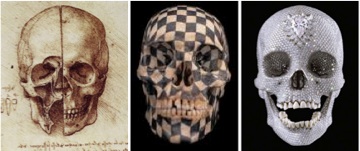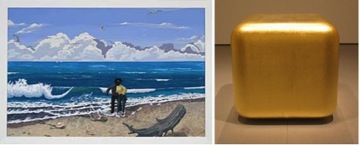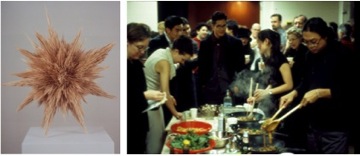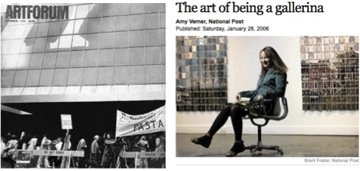
Hans Haacke, "Shapolsky et al. Manhattan Real Estate Holdings, A Real-Time Social System, as of May 1, 1971." 1971.
In the late-1990s I took a graduate seminar on “museums and institutional critique” that focused on artistic and curatorial practices in the 1980s and 90s, and included a series of guest lectures by artists, curators, and the like. It became a bit of a joke that during each class there’d come a point in the conversation where we’d be talking about how an artwork, exhibition, or program was put together, and I’d always raise my hand and ask how it was funded. (Foreshadowing my future career in fundraising, perhaps?)

Leonardo da Vinci, view of a skull, c. 1489. Gabriel Orozco, "Black Kites," 1997. Damian Hirst, "For the Love of God," 2007.
Asking these questions was not a matter of tabloid curiosity, or an exercise in mapping the dirty money that fuels lofty aesthetic pursuits ala Hans Haacke’s Shapolsky et al. Manhattan Real Estate Holdings, A Real Time Social System, as of May 1, 1971. Instead, it always seemed to me that how art is funded tells us something about the way it participates in a larger network of institutions, markets, and audiences. The questions of how art is valued and how it is monetized inevitably overlap: artworks perceived as “important” yield high prices at auction; economic development funding goes to out-of-the-way cultural institutions that bring high quality programming and consequently, tourists, to their neighborhoods; exhibitions that push boundaries attract grants from foundations dedicated to promoting free speech; arts education is consistently underfunded.

Kerry James Marshall, "Untitled," 2008. James Lee Byars, "The Perfect Table," 1989.
How many times have you asked yourself how Art21-featured artists were able to fund a large scale project – Ann Hamilton’s Corpus, for instance, or Cai Guo-Qiang’s Inopportune: Stage One? Or wondered who buys works by Iñigo Maglano Ovalle, Kerry James Marshall, or Janine Antoni and how much they pay? Buried within questions about the economics of art, are assumptions and often, judgments, about its value that beg to be examined: How is the value of an artist’s intellectual versus physical labor calculated? Are collectible works valued differently than ephemeral projects?

Tom Friedman, "Untitled," 1995. Rirkrit Tiravanija, "Unititled," 2002.
How does individual “taste” and critical reception affect the value of an artwork, exhibition, or institution? What factors influence the way we value an artistic experience, as individuals and as a society?
How do we quantify the intangible benefits that art education provides? How do we talk about the subtle and personal value that art has in our lives?

1971 cover of Artforum featuring the PASTA strike; 2006 National Post article on the "gallerina" phenomenon.
The current global financial crisis has given the question “What is the value of art?” a new urgency as we come to terms with not only a downturn in the art market, but with the larger societal changes caused by the crisis that are sure to affect the way art is made, distributed, valued, and consumed in the coming years. Over the next two months Flash Points will present a multifaceted look at both topical issues—recent deaccessioning controversies, how the recession is affecting artists and institutions—as well as explore larger philosophical issues about the deeply complicated relationship between art and money, and tackle thorny questions about the value of art in our individual lives.
We welcome your input. Please feel free to comment, share ideas on what you’d like to see here, and post questions for our regular writers, guest bloggers, and Art21 staff.




Pingback: Money Changes Everything | Art21 Blog
Pingback: Flash Points: What is the value of art? | Art21 Magazine
Pingback: What is the value of art? | LOT80 Studio
Pingback: What is the value of art? - 1-954-270-7404